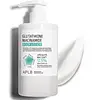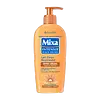APLB Glutathione Niacinamide Body Lotion Versus Mixa Lait Corps Nourrissant Effet Soleil Peaux Mates
What's inside
What's inside
 Key Ingredients
Key Ingredients

 Benefits
Benefits

 Concerns
Concerns

 Ingredients Side-by-side
Ingredients Side-by-side

Water
Skin ConditioningCentella Asiatica Extract 12.3%
CleansingGlycerin
HumectantCetyl Ethylhexanoate
EmollientCetearyl Alcohol
EmollientGlyceryl Stearate
EmollientGlutathione
Niacinamide
SmoothingMadecassic Acid
Skin ConditioningAsiaticoside
AntioxidantAsiatic Acid
Skin ConditioningSolanum Melongena Fruit Extract
Skin ConditioningMelaleuca Alternifolia Leaf Extract
PerfumingHydrolyzed Collagen
EmollientBeta-Glucan
Skin ConditioningHippophae Rhamnoides Fruit Extract
Skin ConditioningNelumbo Nucifera Extract
Skin ConditioningArtemisia Annua Extract
MaskingOryza Sativa Extract
AbsorbentSaccharomyces Ferment
Skin ConditioningSqualane
EmollientSodium Hyaluronate
HumectantDipropylene Glycol
HumectantButylene Glycol
HumectantHydrogenated Lecithin
EmulsifyingCholesterol
EmollientXanthan Gum
EmulsifyingPotassium Hydroxide
BufferingDisodium EDTA
Caprylic/Capric Triglyceride
MaskingCyclopentasiloxane
EmollientCyclohexasiloxane
EmollientSaccharide Hydrolysate
HumectantSorbitan Stearate
EmulsifyingDimethicone
EmollientPEG-100 Stearate
Stearic Acid
Cleansing1,2-Hexanediol
Skin ConditioningChlorphenesin
AntimicrobialCarbomer
Emulsion StabilisingCaprylyl Glycol
EmollientWater, Centella Asiatica Extract 12.3%, Glycerin, Cetyl Ethylhexanoate, Cetearyl Alcohol, Glyceryl Stearate, Glutathione, Niacinamide, Madecassic Acid, Asiaticoside, Asiatic Acid, Solanum Melongena Fruit Extract, Melaleuca Alternifolia Leaf Extract, Hydrolyzed Collagen, Beta-Glucan, Hippophae Rhamnoides Fruit Extract, Nelumbo Nucifera Extract, Artemisia Annua Extract, Oryza Sativa Extract, Saccharomyces Ferment, Squalane, Sodium Hyaluronate, Dipropylene Glycol, Butylene Glycol, Hydrogenated Lecithin, Cholesterol, Xanthan Gum, Potassium Hydroxide, Disodium EDTA, Caprylic/Capric Triglyceride, Cyclopentasiloxane, Cyclohexasiloxane, Saccharide Hydrolysate, Sorbitan Stearate, Dimethicone, PEG-100 Stearate, Stearic Acid, 1,2-Hexanediol, Chlorphenesin, Carbomer, Caprylyl Glycol
Water
Skin ConditioningDimethicone
EmollientGlycerin
HumectantC12-15 Alkyl Benzoate
AntimicrobialStearyl Alcohol
EmollientAlcohol Denat.
AntimicrobialHydrogenated Starch Hydrolysate
HumectantDihydroxyacetone
Skin ConditioningGlyceryl Stearate
EmollientCeteareth-15
EmulsifyingPEG-100 Stearate
Sorbitan Oleate
EmulsifyingGlycine Soja Oil
EmollientDimethiconol
EmollientIsohexadecane
EmollientSodium Polyacryloyldimethyl Taurate
Emulsion StabilisingHaematococcus Pluvialis Extract
AntioxidantPrunus Armeniaca Kernel Oil
MaskingTocopherol
AntioxidantHydroxyacetophenone
AntioxidantCaprylyl Glycol
EmollientCaprylic/Capric Triglyceride
MaskingCitric Acid
BufferingSynthetic Fluorphlogopite
Butyrospermum Parkii Butter
Skin ConditioningPolysorbate 80
EmulsifyingCI 15985
Cosmetic ColorantCI 77891
Cosmetic ColorantParfum
MaskingWater, Dimethicone, Glycerin, C12-15 Alkyl Benzoate, Stearyl Alcohol, Alcohol Denat., Hydrogenated Starch Hydrolysate, Dihydroxyacetone, Glyceryl Stearate, Ceteareth-15, PEG-100 Stearate, Sorbitan Oleate, Glycine Soja Oil, Dimethiconol, Isohexadecane, Sodium Polyacryloyldimethyl Taurate, Haematococcus Pluvialis Extract, Prunus Armeniaca Kernel Oil, Tocopherol, Hydroxyacetophenone, Caprylyl Glycol, Caprylic/Capric Triglyceride, Citric Acid, Synthetic Fluorphlogopite, Butyrospermum Parkii Butter, Polysorbate 80, CI 15985, CI 77891, Parfum
 Reviews
Reviews

Ingredients Explained
These ingredients are found in both products.
Ingredients higher up in an ingredient list are typically present in a larger amount.
This ingredient is an emollient, solvent, and texture enhancer. It is considered a skin-softener by helping the skin prevent moisture loss.
It helps thicken a product's formula and makes it easier to spread by dissolving clumping compounds.
Caprylic Triglyceride is made by combining glycerin with coconut oil, forming a clear liquid.
While there is an assumption Caprylic Triglyceride can clog pores due to it being derived from coconut oil, there is no research supporting this.
Learn more about Caprylic/Capric TriglycerideCaprylyl Glycol is a humectant and emollient, meaning it attracts and preserves moisture.
It is a common ingredient in many products, especially those designed to hydrate skin. The primary benefits are retaining moisture, skin softening, and promoting a healthy skin barrier.
Though Caprylyl Glycol is an alcohol derived from fatty acids, it is not the kind that can dry out skin.
This ingredient is also used as a preservative to extend the life of products. It has slight antimicrobial properties.
Learn more about Caprylyl GlycolDimethicone is a type of synthetic silicone created from natural materials such as quartz.
What it does:
Dimethicone comes in different viscosities:
Depending on the viscosity, dimethicone has different properties.
Ingredients lists don't always show which type is used, so we recommend reaching out to the brand if you have questions about the viscosity.
This ingredient is unlikely to cause irritation because it does not get absorbed into skin. However, people with silicone allergies should be careful about using this ingredient.
Note: Dimethicone may contribute to pilling. This is because it is not oil or water soluble, so pilling may occur when layered with products. When mixed with heavy oils in a formula, the outcome is also quite greasy.
Learn more about DimethiconeGlycerin is already naturally found in your skin. It helps moisturize and protect your skin.
A study from 2016 found glycerin to be more effective as a humectant than AHAs and hyaluronic acid.
As a humectant, it helps the skin stay hydrated by pulling moisture to your skin. The low molecular weight of glycerin allows it to pull moisture into the deeper layers of your skin.
Hydrated skin improves your skin barrier; Your skin barrier helps protect against irritants and bacteria.
Glycerin has also been found to have antimicrobial and antiviral properties. Due to these properties, glycerin is often used in wound and burn treatments.
In cosmetics, glycerin is usually derived from plants such as soybean or palm. However, it can also be sourced from animals, such as tallow or animal fat.
This ingredient is organic, colorless, odorless, and non-toxic.
Glycerin is the name for this ingredient in American English. British English uses Glycerol/Glycerine.
Learn more about GlycerinGlyceryl Stearate is a mix of glycerin and stearic acid.
It is used to stabilize the mixing of water and oil ingredients. By preventing these ingredients from separating, it can help elongate shelf life. It can also help thicken the product's texture.
As an emollient, it helps soften skin and supports barrier-replenishing ingredients.
In cosmetics, Glyceryl Stearate is often made from vegetable oils or synthetically produced.
This ingredient may not be fungal-acne safe
Fun fact: The human body also creates Glyceryl Stearate naturally.
Learn more about Glyceryl StearatePeg-100 Stearate is an emollient and emulsifier. As an emollient, it helps keep skin soft by trapping moisture in. On the other hand, emulsifiers help prevent oil and water from separating in a product.
PEGS are a hydrophilic polyether compound . There are 100 ethylene oxide monomers in Peg-100 Stearate. Peg-100 Stearate is polyethylene glycol ester of stearic acid.
Water. It's the most common cosmetic ingredient of all. You'll usually see it at the top of ingredient lists, meaning that it makes up the largest part of the product.
So why is it so popular? Water most often acts as a solvent - this means that it helps dissolve other ingredients into the formulation.
You'll also recognize water as that liquid we all need to stay alive. If you see this, drink a glass of water. Stay hydrated!
Learn more about Water